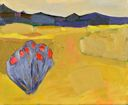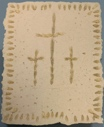Adeïne de la Noë does not have an image.
American, born France Taos Moderns
American, born France, (1914–1987)
Adeine de la Noë was born and raised in France. In 1936 and ’37 she studied at the Beaux Arts, Lille, France, and won a first prize and a trip to Holland. The next year she painted a mural for the Press Pavillion at the International Fair at Lille. For a time de la Noë studied in Paris, but left because “It gave me claustrophobia, when I paint I don’t have a foot on this earth, I’m in a dream”.
de la Noë came to the U.S. in 1956 and studied at the Art Students League under Maurice Kantor as well as with the well known Abstract Expressionist Hans Hoffmann for two years in New England. The Pratt Graphique in New York awarded her a scholarship for 1960-61 and she also attended the Blatt Potterie Ceramique. But she couldn’t be held in the city too long and soon wanted to taste the freedom of the west. On a trip to California, de la Noë stopped in Taos, NM and fell in love with the light. She moved to Taos in 1961 for a residency at the Wurlitzer Foundationo and bought an old adobe in Talpa. Artist Earl Stroh described de la Noë as “a serious modern painter, one who never sold out.” She taught numerous art classes and continued her own artist journey as a painter, printmaker and craftsmen. de la Noë describes her work as emotive, not intellectual, she strived to convey life and beauty. The Taos mountain held de la Noë close for more than 28 years. Her artwork is in collections throughout the United States and Europe.
She was a strong and welcome addition to the group of modern artists, the Taos Moderns, who were already well established by 1961, and she became good friends with several of these artists, including Agnes Martin. Adeïne would remain in Taos until the end of her life, becoming an active member of the Taos art colony and one of Taos' most respected artist. Similar to many artists in Taos, de La Noë stayed because of the incredible light. Highly influenced by the Abstract Expressionist movement in New York, she painted non-figurative and landscape work with her later works being mostly of color fields. As one of the later Taos Moderns, Adeïne was most directly influenced by Abstract Expressionism in her landscapes and non-figurative paintings, both directly based on forms in nature.
For her, this included sometimes incorporating natural objects such as river-washed gravel into her paintings with a heavy palette knife and gravel texture technique, as well as delicate translucent washes. Adeïne was more interested in the emotion that propelled her work to completion, rather than the "idea" itself.
Sources: The Taos News, Thursday, July 7, 1988: "Arts Elusive Minimalist Honored with a Memorial at Harwood," Linda Tasch Contributor and "Modernists in Taos from Dasburg to Martin", by David L. Witt
Arches #5 1993.064
Arroyo 1993.070
Chilkoot Pass #1 1993.093
Latin Cross Wall Hanging BC.1992.164
Tres Cruces (Three Crosses) BC.1992.242




